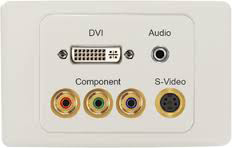Wiring Then And Now

Seriously kids, this was cutting edge in 1997!
It feels like a million years ago that pulling wire in residential installations almost exclusively meant speaker wire. AV pros who’ve been around long enough have seen a lot of changes since then. And at the risk of sentimentality or applying too much nostalgia to the past, the changes that have come and gone in system wiring even just in my time have been a roller coaster ride.
For awhile there, we saw an explosive proliferation of cabling that I liken to the Cambrian Explosion, when new life forms bloomed in increasingly greater variety 541 million years ago. Suddenly, instead of just speaker wire, RG-59 cables and maybe two-conductor wire for security or relays, AV pros were running all of that plus numerous coaxial cables for video. And that’s not counting the number of specialized multi-cables that some brands (Crestron comes to mind) were offering. And just like biodiversity, with technological advances there were a few wrong turns along the way.

I really am.
To those few clients for whom I specified S-video cables in-wall in your house: I’m sorry.
And to those few clients for whom I specified and charged way too much money for a really ridiculously long HDMI cable to the projector: I’m so sorry.
It’s scenarios like the above that make me raise my eyebrow when we talk about future-proofing client’s projects.
All of us — you, me and AV pros you know — have completed projects in the past that, at the time, we thought were future-proof, but hindsight leaves us shaking our heads.
Realistically, the only truly future-proof pre-wire specification is to run conduit all through the house, like some sort of giant hamster habitat. That at least would allow semi-annual visits to yank out obsolete cables and replace them with whatever the client needs next.
The good news is that technological progress has allowed AV pros to do more with less.

DVI, Component AND S-video on a wall plate? Pinch me.
What do I mean by that? Fewer cables, overall.
Remember in the early days of video distribution over Cat5e? There were competing brands of video extenders that punted Y/Pb/Pr over two or even three Cat5e cables. Not long after, HDMI extenders appeared on the scene, again, sending the signals over two or three cables.
And eventually, it was possible to get HDMI down to a single network cable. That was a relief.
While the march of progress has meant changes to the details of how you wire, what you wire and why, some practices still remain.
The first is choosing the right wire for the job, which seems like a topic that can run away to become its own article, or even a series of articles. The too long/didn’t read version would probably sum up as “the best rated network cable you can get your hands on.” I’ll leave it to readers to argue over that in the comments.
Just as you shouldn’t scrimp on the Ethernet cable, at the same time don’t cheap out on any of the network hardware, routers, switches, etc. that your system requires. The devil is always in the details and more AV Pros than not recognize the upfront cost of enterprise-grade hardware is offset by fewer service issues down the road.
My favorite tip and one that is alarming to consider anyone overlooking: Label every cable at each end with its function and its location. A label maker trumps a sharpie marker, although even that is better than nothing. Affix the labels far enough from the wire ends so that they don’t get removed when the wires are stripped and terminated.
“What about the future?”, you ask. Well, what about it? None of us have a crystal ball, although we try to get it right. And there’s an excellent chance that this editorial won’t hold up to the test of time and I’ll be cringing at it ten years from now. In the meantime, we do the best we can.





